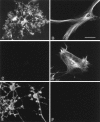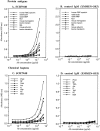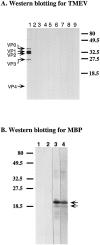Targeting of IgMkappa antibodies to oligodendrocytes promotes CNS remyelination
- PMID: 9742140
- PMCID: PMC6793011
- DOI: 10.1523/JNEUROSCI.18-19-07700.1998
Targeting of IgMkappa antibodies to oligodendrocytes promotes CNS remyelination
Abstract
We previously identified the remyelinating activity of a natural IgMkappa oligodendrocyte-reactive autoantibody (SCH94.03), using a virus-induced murine model of multiple sclerosis. We now describe a second mouse IgMkappa monoclonal antibody (mAb) (SCH79.08) raised against normal mouse spinal cord homogenate, which reacts with myelin basic protein and also promotes remyelination. Because these two mAbs recognize different oligodendrocyte antigens, several previously identified oligodendrocyte-reactive IgMkappa mAbs (O1, O4, A2B5, and HNK-1), each with distinct antigen specificities, were evaluated and found to promote remyelination. In contrast, IgMkappa mAbs that did not bind to oligodendrocytes showed no remyelination. One of these, CH12 IgMkappa mAb, which shares variable region cDNA sequences with SCH94.03 except for amino acid differences in the complementarity-determining region 3 in both heavy and light chains, did not bind to oligodendrocytes and did not promote remyelination. The fact that multiple oligodendrocyte-reactive antibodies with distinct antigen reactivities induce remyelination argues against direct activation by a unique cell surface receptor. These findings are most consistent with the hypothesis that the binding of mAbs to oligodendrocytes in the lesions induces myelin repair via indirect immune effector mechanisms initiated by the mu-chain. Importantly, these studies indicate that oligodendrocyte-reactive natural autoantibodies may provide a powerful and novel therapeutic means to induce remyelination in multiple sclerosis patients.
Figures




References
-
- Abo T, Balch CM. A differentiation antigen of human NK and K cells identified by a monoclonal antibody (HNK-1). J Immunol. 1981;127:1024–1029. - PubMed
-
- Asakura K, Miller DJ, Pogulis RJ, Pease LR, Rodriguez M. Oligodendrocyte-reactive O1, O4, and HNK-1 monoclonal antibodies are encoded by germline immunoglobulin genes. Mol Brain Res. 1995;34:283–293. - PubMed
-
- Asakura K, Pogulis RJ, Pease LR, Rodriguez M. A monoclonal autoantibody which promotes central nervous system remyelination is highly polyreactive to multiple known and novel antigens. J Neuroimmunol. 1996a;65:11–19. - PubMed
-
- Asakura K, Miller DJ, Murray K, Bansal R, Pfeiffer SE, Rodriguez M. Monoclonal autoantibody SCH94.03, which promotes CNS remyelination, recognizes an antigen on the surface of oligodendrocytes. J Neurosci Res. 1996b;43:273–281. - PubMed
Publication types
MeSH terms
Substances
Grants and funding
LinkOut - more resources
Full Text Sources
Other Literature Sources
Research Materials
